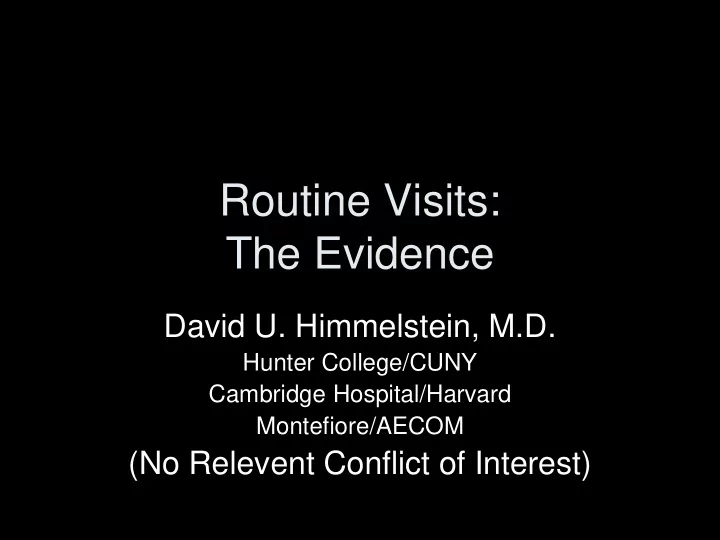

Routine Visits: The Evidence David U. Himmelstein, M.D. Hunter College/CUNY Cambridge Hospital/Harvard Montefiore/AECOM (No Relevent Conflict of Interest)
The NEJM on SGIM’s Position on Annual Visits “Cognitive specialists name very few of their own revenue-generating services. The notable exception is the Society of General Internal Medicine, whose list includes the annual physical, a common visit type for primary care physicians . . . Payers may use lists to inform coverage, payment, and utilization-management decisions.”
In the New York Times . . . “Last month my specialty group — the Society of General Internal Medicine — released its choosing wisely recommendations. No. 2 was ‘don’t perform routine general health checks for asymptomatic adults. . . . Yet, I still do them. Each time I see a healthy patient, I close the visit by saying, ’see you in a year.’ It’s a reflex. . . . But seeing these new, strongly worded recommendations, I may have to re-evaluate.”
Boulware LE, . . . and Bass EB., Systematic Review: The Value of the Periodic Health Evaluation Ann Int Med 2007 “Our definition specified the PHE as consisting only of the history, risk assessment, and a tailored physical examination that could lead to the delivery of preventive services.”
Boulware LE, . . . and Bass EB. Conclusion “Evidence suggests that the PHE improves delivery of some recommended preventive services and may lessen patient worry. Although additional research is needed to clarify long-term benefits, harms, and costs of receiving the PHE, evidence of benefits in this study justifies implementation of the PHE in clinical practice.”
Krogsboll et al Systematic review and Meta-analysis BMJ/Cochane, 2013 • “We defined health checks as screening general populations for more than one disease or risk factor in more than one organ system.” • “We did not include geriatric trials.” • “Some general health checks include a conversation with a health professional.”
Krogsboll et al The 14 Trials (Start Year) • Goteborg (1963) • Salt Lake City (1972) • Kaiser (1965) • Mankato, MN (1982) • SE London (1967) • Oxcheck - UK (1989) • Northumberland (1969) • British Family Heart (1990) • Malmo (1969) • Ebeltoft – Denmark • Stockholm (1969) (1992) • Goteborg (1970) • Inter – Denmark (1999) • WHO - UK, Belgium, Poland, Italy - (1971)
Goteborg (1963) • “The first screening was performed by staff at a local hospital” • Questionnaire, height, weight, skinfold thickness, BP, EKG, UA, lipids, Hct, ESR, Cr, Serum PEP, NA, K, Cl, Blood type, CXR, PE, Opth exam.
SE London (1967) • “The intervention group was invited for two rounds of multiphasic screening, done independently from the participants’ own general practitioner.”
Malmo Trial (1969) • “The participants’ primary care physicians were not involved with the study.”
The Stockholm Trial (1969) • “Participants with an identified need for specialist services were directly referred, whereas participants were instructed to contact their primary care physician for other issues.”
Th Salt Lake City Study (1972) • 642 intervention, 454 controls – mostly low income members of a prepaid health plan • Intervention = 5 x-ray studies, mammogram, Pap, spirometry, EKG, tonometry, audiometry, visual acuity, STD screening, 12 blood tests, 6 urine tests • Analysis excluded those whose economic status changed, did not attend screening, did not consult MD about results, did not attend 1 year f/u. Excluded 51% of intervention, 18% of controls.
The Mankato Trial (1982) • Randomized addresses - 1,156 intervention, 1167 controls • One person from household invited for initial screening • Participants in 1st screen invited for 2 nd screen one year later, as were all controls • Only screened participants were analyzed – missing data for >50%. • “Participants were referred to their regular physician for treatment when necessary.”
The Kaiser Study (1965) • RCT – 5,156 Intervention, 5,557 controls • Gyn exam/Pap, sigmoidoscopy, PE, BP, EKG, CXR, spirometry, tonometry, UA, CBC, chem panel, audiogram, visual acuity • 16 year f/u • 84.3% of intervention pts had at least one health check vs. 64.8% of controls
Summary • Annals: “Evidence justifies implementation” • BMJ: Largely irrelevant – few US trials (where access is worse), assessed multiphasic screening added on to primary care (most controls probably had routine visits). ? More relevant to PCMH than to routine visits • Little evidence on poor, elderly, underinsured • Is evidence stronger for interventions which SGIM supports? – PCMH, ACOs, P4P
Recommend
More recommend